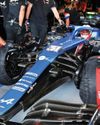
Whether you like or even agree with the concept of electric cars or not, you simply cannot deny the monumental success of the Formula E championship, which has now been granted world championship status by the FIA, from season seven (2020/2021) onwards. With the category’s sixth season already underway, the grid is now 26 cars strong with 11 of the 12 teams manufacturers, including Mercedes-Benz EQ and TAG-Heuer Porsche, who have both entered their rookie season in the championship. This means that for the first time in motorsport history Audi, Mercedes, BMW and Porsche are competing as factory entities in the same series. The closest this had come to pass previously was the 1999 Le Mans 24 hours, although on that occasion the Porsches entered were customer cars.
Alongside the new teams sits some new technical and sporting rules for season six. With each rule carefully designed and implemented to make driver skill and energy management strategies more crucial than ever before, season six could be the most competitive FE championship yet.
Six pack
It was certainly competitive at the Diriyah E-prix in Saudi Arabia, which hosted the first two rounds of the 2019/2020 championship. Drivers using German manufacturer powertrains swept the board, with a win apiece for the BMW i Andretti Motorsport and Envision Virgin Racing, the latter running a customer Audi powertrain. Meanwhile, both the new entries from Porsche and Mercedes secured podiums despite issues in pre-season testing in Valencia – the former with a surprise second place for Andre Lotterer in race one, while Mercedes driver Stoffel Vandoorne claimed a double podium with two third places.
This story is from the February 2020 edition of Racecar Engineering.
Start your 7-day Magzter GOLD free trial to access thousands of curated premium stories, and 8,500+ magazines and newspapers.
Already a subscriber ? Sign In
This story is from the February 2020 edition of Racecar Engineering.
Start your 7-day Magzter GOLD free trial to access thousands of curated premium stories, and 8,500+ magazines and newspapers.
Already a subscriber? Sign In
Talk the torque
More thoughts on in-wheel motors and their effects on twisting force
Rolling about
An explanation of the limitations of a previous load transfer article, bringing jacking forces into the mix
F1 breaks schedule records
The FIA has confirmed no fewer than 23 races on the 2022 Formula 1 World Championship schedule, the highest number of grands prix ever to be held in a single season, and that has led to criticism from some teams that will be on the road for eight months.

Under pressure
Toyota may have finished first and second at Le Mans this year, but the effort required to overcome a fuel delivery problem and finish with both cars was Herculean
Physics at work
Dutch company, Intrax, offers Racecar Engineering an insight into the technologies it employs to optimise its suspension products
Williams' 2030 ambition
Williams Racing has committed to becoming climate positive by 2030 as part of an all-new sustainability strategy.
Diff'rent strokes
Racecar looks at the different types of mechanical differential, their benefits and limitations
Das Boot
A curious Twitter exchange fired up a unique, hydrogen-powered, cross-country project that will contest the Baja 1000 in November 2022

Air born
Every racecar engineer's dream is a blank sheet of paper design. When Hoonigan and Subaru approached Vermont Sportscars about building the next generation of Gymkhana racer, that's just what the company was given

Remote control
Called variously ‘virtual garages’, ‘mission control’ or ‘race support rooms’ is the future of race engineering sitting in the warm back at HQ?